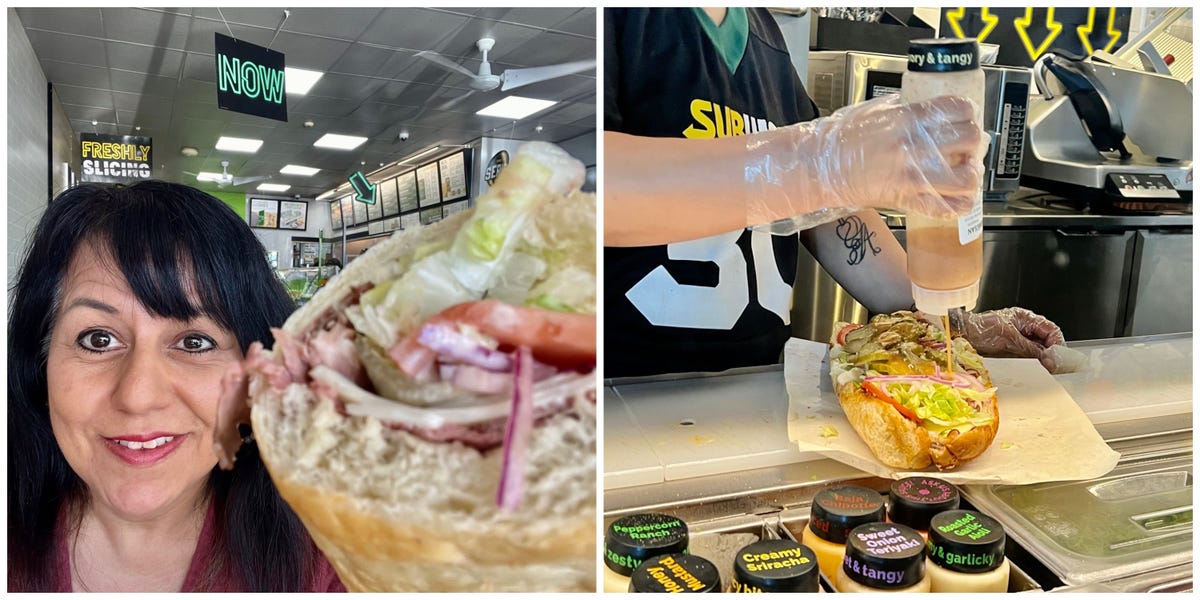- Subway, which has closed hundreds of stores over the years, is being purchased by Roark Capital.
- Roark owns brands such as Dunkin’, Arby’s, and Buffalo Wild Wings.
- We visited four Subway in Southern California to figure out how Roark can fix the brand.
Roark Capital, whose empire of restaurant brands includes Dunkin’, Buffalo Wild Wings, and Arby’s, is taking Subway under its wing.
The private-equity firm is known for buying maverick brands, which is why last week’s purchase of Subway came as a head-scratcher for many in the industry. There’s nothing rebellious or individualistic about Subway.
In its heyday, Subway was considered a pioneer with its walk-along sandwich-making process. But its leadership has been shaky since the death of cofounder Fred DeLuca. Over the years, the chain has downsized stores, laid off corporate staff, and been plagued by the Jared Fogle scandal.
It’s also drastically changed its franchising system’s fundamentals, a business model that has turned many immigrant entrepreneurs into millionaires driving Ferraris and Rolls-Royce luxury cars.
To improve its sales and its relevance, the chain has revamped stores and upgraded its menu by adding more high-quality ingredients.
These changes have improved sales over the past two years, but Roark is still buying a fixer-upper.
I’ve been covering the restaurant industry for two decades, but I haven’t walked into a Subway in a long time. So I visited four Subway stores near my Southern California home.
I learned a lot during my visits. Here’s what Roark should do to fix the brand.
Continue to remodel all stores
The first Subway I hit was the closest one to my home. It’s in an old strip mall, anchored by a Grocery Outlet and a Rite-Aid. I haven’t been inside this Subway in years. It looked fabulous. It is one of hundreds of Subway stores that have been remodeled over the years. The contemporary look was more inviting than other stores I visited.
If Subway wants to compete with modern fast-food rivals like McDonald’s, Roark must insist all stores be upgraded.
But franchisees should not bear the burden of costly upgrades on their own. They have seen their profits grow thinner due to high inflation and labor costs. Owners have the power to help franchisees. In 2020, the owner of Jersey Mike’s funded a $150 million remodel program for franchisees. Last year, Burger King said it would invest $200 million to help its best franchisees remodel restaurants.
As of July, Subway said 10,000 stores have been remodeled in North America, “with more to come.”
Stores are cannibalizing each other. Keep cutting store counts.
Subway grew too fast under Fred DeLuca, and franchisees continue to pay the price for the greedy growth trajectory. The Miami-based chain closed more than 6,500 restaurants between 2015 and 2022, and its US store count stood at 20,576 at the end of last year, according to the market-research firm Technomic.
They need to trim more fat.
Take where I live in Southern California.
There are 20 Subway restaurants less than three miles from where I live in Orange, California. Of those, 50% have another store 0.1 miles or less from another Subway. There’s not enough interest in Subway to sustain these restaurants.
I visited four of these stores at lunch and dinner. Each time, there were three or fewer people ordering food. In most cases, I was the only person ordering food.
Still, the analytics firm Placer.ai says foot traffic at Subway has inched up this year. In July, visits were up 0.4% year over year, but traffic was still down 18.5% compared to July 2019. In May, traffic was down 21.6% compared to four years ago.
Fix the bread and the tuna
In 2021, Subway rolled out artisanal loaves of bread, upgraded soups, and added new meats and dressings. It was billed as the most extensive menu update in the brand’s history.
One thing they didn’t upgrade was the tuna, which has been the subject of controversy for years. In lawsuits and media publications, Subway has been accused of mislabeling its tuna because the product sold in stores does not contain actual tuna fish. In 2021, The New York Times conducted its lab test and published a report stating that it found no tuna DNA in Subway tuna sandwiches.
Subway has called these accusations meritless. In fact, they are so confident in their tuna that it was the one item they didn’t upgrade during the big 2021 menu overhaul.
“While many of Subway’s core protein choices were improved as part of the Eat Fresh Refresh, one ingredient that doesn’t need an upgrade is the Subway high-quality, premium tuna,” the company stated in 2021. “Subway sources tuna from leading global food suppliers that have a reputation for working diligently with food safety and quality experts to ensure consistent, high-quality products at every stage of the supply chain. The 100% wild-caught tuna remains a fan favorite among sub lovers.”
I ordered the tuna sandwich at a Subway in Santa Ana, California, an aging stand-alone store in a former adobe-style Taco Bell building. The 6-inch sandwich, served on white artisanal Italian bread, came with two scoops of tuna that looked more like tuna spread. The sandwich artist put only two tiny scoops in the middle of the bread loaf. The ingredients I added — onions, lettuce, and pickles —overpowered the tuna.
It tasted like tuna, but I would not call this a premium product.
Now, let’s talk about the bread. There’s nothing artisanal about these newly formulated loaves. During my four visits, I tried the artisanal Italian, the hearty multigrain, and the Italian herb-and cheese bread. Subway said it tapped “a panel of world-class bakers over two years to develop” these new recipes.
It needs to tap a few more bakers, because the bread is terrible. Each store served bread that was stale and flavorless. Even the herb-and-cheese bread had no flavor to it. A stale French baguette tastes better than these loaves.
Keep your stores clean and stocked
Three of the four stores I visited had dirty floors and tables. Usually, I give a restaurant a pass on this if there are lines out the door and there’s no staff available for busing and cleaning tables. But most of the stores I went to were empty.
The unkempt restaurants looked especially terrible in the remodeled stores.
A Subway Cafe near Chapman University in Orange was filthy. At least three employees were working, and I was the only customer in the store.
Subway and its franchises have spent millions of dollars remodeling stores; they should look nice.
Tim Powell, a restaurant consultant who has worked with Roark on other acquisitions, said the “issues that plague” Subway are incorrect orders, long wait times, and inattentive staff.
“Roark’s challenge will be operational — finding ways to keep lines moving, orders accurate, and prices in line with what consumers are receiving will be the very first step,” Powell said.
Also, most of the workers I encountered were disengaged.
I had an odd interaction with one employee when ordering a meatball marinara sandwich. While he was prepping the subs, he said: “I don’t have Parmesan.”
The sandwich is supposed to come sprinkled with Parmesan cheese.
When I asked why, he said: “My boss took the Parmesan home.”
Are you a Subway insider with insight to share? Got a tip? Contact this reporter via email at [email protected] or at 714-269-8873.
Read the full article here





